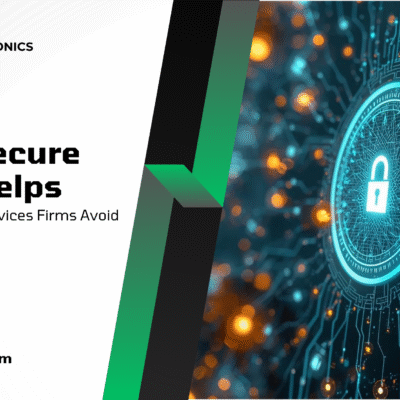Introduction
In today’s digital economy, data is the most valuable asset for organizations across every sector. From tech startups to global enterprises, companies are increasingly data-driven — relying on analytics, cloud platforms, AI, and massive storage infrastructures to deliver products and services. But as data volumes grow, so do the risks.
What often gets overlooked is what happens when IT assets reach end-of-life. Retired servers, storage arrays, laptops, and mobile devices may still contain sensitive data. If not disposed of securely, these assets can expose organizations to data breaches, compliance failures, and financial loss.
This is where IT Asset Disposition (ITAD) becomes mission-critical. For data-driven companies, scaling ITAD programs is not just an operational task — it’s a strategic initiative that supports security, compliance, and sustainability in the digital age.
The Risks of Ignoring ITAD in Data-Heavy Businesses
Increasing Volumes of Retired Assets
As businesses expand their data footprint, refresh cycles accelerate. Cloud migrations, digital transformation, and edge computing create a constant stream of decommissioned devices.
Regulatory Complexity
Data-driven organizations must comply with overlapping frameworks:
- General Data Protection Regulation (GDPR) for personal data in the EU European Commission GDPR IER Blog List.
- California Consumer Privacy Act (CCPA) for California residents’ data State of California DOJ CCPA IER Blog List.
- Federal Trade Commission (FTC) Safeguards Rule for financial data FTC Safeguards Rule IER Blog List.
- NIST SP 800-88 requirements for secure data sanitization NIST SP 800-88 Rev.1 IER Blog List.
Failure to dispose of assets securely can result in fines, lawsuits, and reputational damage.
Cybersecurity Threats
According to Verizon’s 2023 Data Breach Investigations Report IER Blog List, 74% of breaches involve the human element — including errors like improper disposal of devices. For data-driven firms, each overlooked asset represents a potential breach.
Certified ITAD: The Scalable Solution
Working with a certified ITAD provider ensures:
- Data Sanitization & Destruction: Secure disposal aligned with NIST 800-88 IER Blog List.
- Chain of Custody: Serialized tracking from collection to final disposition.
- Certificates of Destruction: Audit-ready compliance documentation.
- Scalability: Ability to manage hundreds or thousands of devices across multiple sites.
- Sustainability: Reuse and recycling programs that support corporate ESG goals.
Step-by-Step Best Practices for Scaling ITAD
1. Centralize IT Asset Management
Maintain a master inventory across all business units. Use asset management software to track devices from purchase to retirement.
2. Define a Global ITAD Policy
Standardize ITAD policies across geographies. Align with GDPR, CCPA, and other applicable frameworks. Specify acceptable sanitization methods, chain-of-custody requirements, and documentation standards.
3. Select Enterprise-Grade ITAD Partners
Choose providers with certifications such as R2v3, NAID AAA, and ISO 27001. Ensure they can support multiple sites, global operations, and large-scale projects.
4. Automate Processes Where Possible
Integrate ITAD workflows into ITSM or asset management systems. Trigger ITAD when assets reach end-of-life, ensuring consistent execution.
5. Maintain Chain-of-Custody Documentation
Require serialized asset tracking, tamper-evident containers, and GPS-tracked transportation.
6. Audit Vendors Regularly
Conduct annual audits of ITAD partners. Require evidence of compliance, process controls, and sustainability reporting.
7. Train Employees Across the Enterprise
Include ITAD awareness in employee security training to reduce human error in asset disposal.
Sustainability Metrics for Data-Driven Companies
As ESG reporting becomes standard, companies can demonstrate sustainability impact through ITAD:
- Diversion Rate (%): Percent of assets diverted from landfills.
- CO₂ Savings: Emissions avoided by refurbishing/reusing hardware instead of manufacturing new.
- Reuse Rate: Percentage of devices resold, donated, or redeployed internally.
- Material Recovery: Quantities of metals, plastics, and rare earth elements recovered.
- Hazardous Waste Avoidance: Tracking toxins (e.g., lead, mercury) safely processed.
Publishing these metrics in ESG reports demonstrates responsible data stewardship and environmental leadership.
FAQs: ITAD for Data-Driven Companies
Q1: Can we resell retired devices securely?
A: Yes, if sanitized per NIST SP 800-88 and certified by a provider. Many companies generate ROI through resale or redeployment.
Q2: How does ITAD integrate with data privacy laws like GDPR and CCPA?
A: Secure disposal ensures personal data is “erased” in compliance with GDPR’s right to erasure and CCPA’s consumer data protection requirements.
Q3: What happens if an employee improperly disposes of a device?
A: Human error is a leading breach cause. Training and automated ITAD workflows reduce the risk.
Q4: How can ITAD scale with rapid cloud adoption?
A: ITAD applies to physical assets (servers, drives, laptops) even as workloads move to the cloud. Large-scale cloud migrations often generate high volumes of retired hardware needing secure disposal.
Q5: How long should we keep ITAD documentation?
A: At least as long as required by applicable laws (GDPR, CCPA, FTC) and internal audit cycles — typically 5–7 years.
Conclusion
For data-driven organizations, ITAD is a core component of information security and compliance. Scaling ITAD programs ensures secure disposal of retired assets, prevents breaches, and demonstrates accountability to regulators and stakeholders.
With a certified ITAD partner, companies can manage large volumes of devices securely, comply with global data privacy laws, and meet sustainability goals.
CTA:
➡️ Ready to scale your ITAD strategy? Contact IER today to learn how our certified services can protect your data and support ESG goals.



